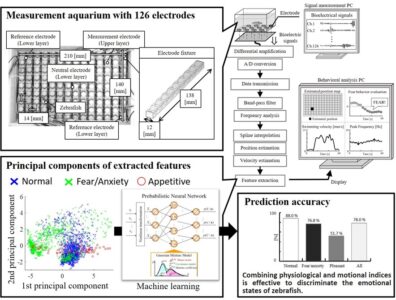Emotional states such as fear, anxiety, and pleasure in zebrafish (Danio rerio) are generally evaluated by video-based behavioral analysis. In contrast, we have proposed a system that can measure bioelectrical signals called ventilatory signals using 126 electrodes placed on the bottom of an aquarium and have realized real-time analysis of movement and respiration without a camera. In this study, we combined the motion and respiration indices obtained by the proposed system to identify the emotional state of zebrafish. In the experiment, we induced fear/anxiety and pleasure states using an alarm pheromone and ethanol, respectively. As a result of analyzing the measured bioelectrical signals, it was found that the emotional state of zebrafish can be expressed on the principal component space of motion and respiratory indices. We then used the Log-linearized gaussian mixture network, a discriminator developed in our laboratory that includes a statistical model, to discriminate three emotional states every 5 seconds, and obtained the F-score, an index of discrimination accuracy. The F-scores were 0.84 for the normal state, 0.76 for the fear/anxiety state, and 0.59 for the pleasure state. These results indicate that zebrafish’s emotional state can be estimated by combining physiological and motion indices.
Resarch topics
Emotion Estimation of Zebrafish Based on Bioelectric Signals

References
Measurement of Emotional States of Zebrafish through Integrated Analysis of Motion and Respiration Using Bioelectric Signals
Zu Soh, Motoki Matsuno, Masayuki Yoshida, Akira Furui, and Toshio Tsuji
Scientific Reports, volume 11, Article number: 187, doi.org/10.1038/s41598-020-80578-6, Published online: 08 January 2021. (SCI, IF=3.998)


